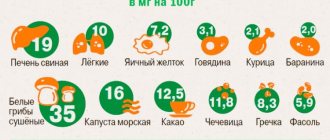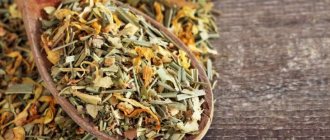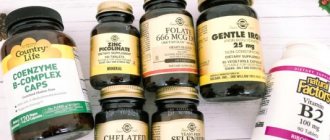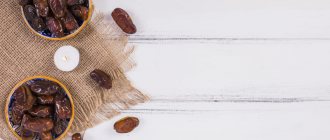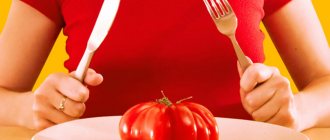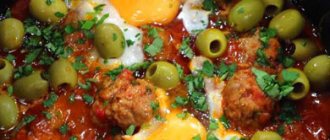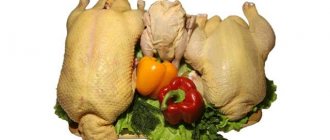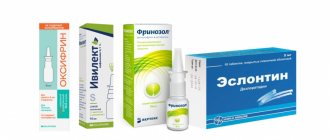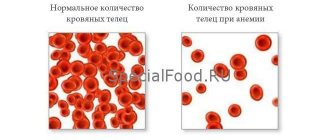Increased hemoglobin is a rather dangerous condition, which in 90% of cases indicates disruptions in the metabolic processes occurring in the body.
This may also mean that tissues and organs experience oxygen starvation, and increased hemoglobin is the body’s protective reaction to a decrease in the amount of micronutrients received.
In any case, according to research , it is possible, in most cases, to lower hemoglobin levels in men and women with the help of a specialized diet. What products best reduce it? And which ones, on the contrary, should not be consumed?
When should hemoglobin be reduced?
In most cases, an increase in hemoglobin levels in adults is complemented by an increase in blood viscosity due to impaired water-salt metabolism. And thick blood leads to an increased risk of blood clots and plaques, and coagulation also increases. All this can be supplemented:
- hypertension (increased blood pressure to a critical level);
- thrombosis (if the blood flow slows down to the point where the blood literally coagulates in some vessels);
- heart attack (if thrombosis affects the heart muscle or the blood vessels that supply it);
- stroke (if thrombosis affects the circulatory system of the brain);
- atherosclerosis (when cholesterol plaques form on the walls of blood vessels, thereby impeding normal blood flow).
At the same time, an increase in hemoglobin may indicate pathologies in metabolic processes when the body receives insufficient amounts of oxygen and other micronutrients.
In some cases, elevated hemoglobin is normal. This happens, for example, among residents of mountainous regions, where the oxygen content in the air is significantly lower.
Also, hemoglobin and red blood cells naturally increase in smokers, since they inhale fumes while smoking. It, in turn, creates inseparable compounds with hemoglobin, thereby deactivating the molecule. In these cases, the hemoglobin level should not be reduced, since the body will experience constant oxygen starvation.
Hemoglobin also often increases in the summer or during regular physical activity, when the body actively loses water and minerals (along with sweat). But normalizing hemoglobin concentration in this case is quite simple - you need to drink as much water as possible (in summer - from 3 liters or more).
Hidden iron deficiency - how to deal with it?
I feel bad, constant weakness. I took a blood test and the doctor said it was normal. Tell me what to do...
If you get tired quickly, often suffer from acute respiratory viral infections, if you are worried about hair loss, brittle nails, dry skin, if “everything hurts, nothing helps” - it’s time to rule out iron deficiency, says OKDC doctor-therapist Tatyana Abramova
There are more and more “iron deficient” people...
Today, iron deficiency is the most common pathology. According to some reports, more than 1.5 billion people on our planet have iron deficiency. Iron deficiency anemia itself is not a disease, but it can become a symptom of a serious pathology.
The biological role of iron in the body is great - it is involved in redox processes, tissue growth and aging, immunity mechanisms, hematopoiesis, oxygen supply to organs and tissues, and the functioning of a number of enzymes.
Lack of iron and subsequent tissue and hemic hypoxia lead to significant trophic changes in hair, thinning, increased hair loss and even early greying. Along with this, brittleness of the nails, their transverse striations, jagged edges of the nails, curvature of the nail plate, flattening or concavity of the nails up to spoon-shaped appear. In this case, urinary incontinence is often observed. A perversion of taste occurs in the form of an addiction to raw meat, dough, chalk, tooth powder, etc. Patients are attracted to the smells of mold, gasoline, kerosene or acetone.
Sometimes iron deficiency leads to atrophy of the mucous membrane of the tongue, angular stomatitis, glossitis, dental caries and muscle weakness. An increase in temperature to subfebrile levels can also be a manifestation of iron deficiency.
Everything hurts...
What could be the connection between iron deficiency anemia and back pain? Imagine not getting enough sleep for several nights in a row. The body then seems sluggish, disobedient, heavy, pain appears or intensifies in those places of the spine in which it was previously felt. People suffering from chronic iron deficiency anemia experience something similar. In addition to general weakness, malaise, brittle nails and hair loss, they may also experience persistent back pain. And some complain that “everything hurts.” To understand why this happens, remember that iron deficiency anemia is characterized by a low level of hemoglobin in the blood, which is a transporter for oxygen. A person with a low hemoglobin content can breathe the purest air in a pine forest, but oxygen in the required quantity will not enter the body’s cells, because there is not enough transport - hemoglobin. In turn, oxygen is an oxidizing agent, thanks to which metabolic processes occur in cells. Not enough - they accumulate under-oxidized metabolic products, essentially poison, poisoning the body and disrupting its functioning.
Hence the weakness and lethargy, as in case of poisoning, and increased muscle fatigue. And if we take into account that nervous tissue is most sensitive to hypoxia, then the strange at first glance complaint of patients that “everything hurts” also finds an explanation.
Patients go to a neurologist, gastroenterologist or cardiologist; they have disorders of the cardiovascular system, myocardial dystrophy; vegetative-vascular and vestibular disorders occur. People suffer from frequent colds and acute respiratory infections, problems with the digestive system and kidneys. They undergo treatment for a long time, follow the instructions of specialists, but find that the expected recovery and improvement in quality of life does not exist, or they are short-lived. And all this is only because they overlooked an important one - iron deficiency. In such cases, the therapist had to conduct all the necessary research and identify the true causes of the ailment.
And there can be a lot of reasons for iron deficiency, and they are very different:
- chronic blood loss of various locations: gastrointestinal (gastroesophageal reflux disease, erosive and ulcerative lesions of the stomach, tumors of the stomach and colon, terminal ileitis, ulcerative colitis, diverticulitis, bleeding hemorrhoids);
- menstrual blood loss (menorrhagia of various etiologies, fibroids, endometrosis);
- nasal (hereditary hemorrhagic telangiectasia and other hemorrhagic diathesis);
- iron absorption disorders
- resection of the small intestine, stomach with exclusion of the duodenum;
- increased need for iron: pregnancy, lactation, intensive growth and puberty;
- impaired iron transport (hypoproteinemia of various origins);
- nutritional deficiency.
Hidden threat
The most unpleasant thing is that latent (hidden) iron deficiency is widespread among the population, when hemoglobin levels are still normal, but transport and organ reserves of iron are already depleted. This “disguised” deficit ranges from 19.5 to 30%. In addition, 50 to 86% of women in various populations have risk factors for anemia. Therefore, the Regional Consultative and Diagnostic Center has introduced the most modern methods for identifying hidden processes of changes in blood composition and early diagnosis of iron deficiency conditions.
Therapists from the OKDC will always help you to clarify the causes of the development of anemia and iron deficiency, select the right set of diagnostic laboratory tests, and understand the causes of the pathology.
share information
0
Social buttons for Joomla
General nutrition rules
With elevated hemoglobin, nutritionists recommend following the following tips and recommendations:
- Consume foods and dishes rich in calcium. This element reduces the bioavailability of iron. That is, it slows down its absorption. Namely, iron is the main component of hemoglobin and it is with its help that oxygen and carbon dioxide are transported to/from the lungs.
- Eliminate foods rich in vitamins B12 and B9 from your diet. This will also help reduce the bioavailability of iron and slow down the processes of generating new hemoglobin molecules.
- Eliminate iron-rich foods from your diet. These include apples, greens, beef, pork, meat by-products (liver, lungs, heart), fish. Preference should be given to porridge (with the exception of buckwheat), dairy products, and pasta. The diet for each patient must be prepared individually by a nutritionist.
If we are talking about infants, then breast milk helps them normalize hemoglobin. If artificial feeding (formulas) is used, then you should consult a pediatrician about this - he will recommend formulas that contain a minimum of iron and B vitamins.
Norm
The norm in this situation is considered to be 120-140 g/l. Numbers may vary, it all depends on the physical and mental state. A long decrease or increase in comparison with normal data indicates problems in the body.
In women, an increased rate is rarely observed. It is possible for hemoglobin to increase by 10-20 units; if the values are even higher, then you definitely need to go to the doctor and get tested. The reasons may be different: blood disease, congenital heart pathologies, oncology, cardiopulmonary pathology. This plasma substance is present in red blood cells, which are produced by the bone marrow. These scarlet bloody cells transport air to various organs. Therefore, with an increase in hemoglobin, there is probably an air deficiency in some area of the body. Because of it, the bone marrow forms a lot of red blood cells, and plasma coagulability increases.
| Floor | Age | Hemoglobin norm, g/l |
| Children | 0 – 14 days | 135-200 |
| Up to 1 month | 100-170 | |
| 1-2 months | 95-130 | |
| 2-4 months | 100-140 | |
| 4-6 months | 110-140 | |
| 6-9 months | 100-150 | |
| 9-12 months | 115-145 | |
| 1-5 years | 110-150 | |
| 5-10 years | 115-145 | |
| 10-12 years | 120-160 | |
| Man | 12-15 years | 120-160 |
| 15-18 years old | 120-170 | |
| 18-45 years old | 130-170 | |
| 45-60 years | 140-175 | |
| Over 60 years old | 120-175 | |
| Woman | 12-15 years | 110-150 |
| 15-18 years old | 120-155 | |
| 18-45 years old | 115-160 | |
| 45-60 years | 120-160 | |
| Over 60 years old | 110-170 |
What should be excluded from the diet?
For greater effectiveness, when following a diet, be sure to exclude from the diet foods that cannot be eaten with increased hemoglobin:
- Fat meat. Particularly “dangerous” are beef, pork, as well as meat by-products (liver, lungs, heart, kidneys, and so on). Meat is rich in iron, as well as B-group vitamins (therefore, iron from such products is easily absorbed).
- Pomegranate and pomegranate juice. Pomegranate increases hemoglobin and blood pressure. For hypotension, it is extremely useful to include in the diet, but with increased blood viscosity, it should be completely excluded.
- Fatty fish. Rich in omega-3 acids, which accelerate most intercellular metabolic processes. Their use should be minimized. You can also include other seafood here, including oysters, shrimp, red and black sparkle, and seaweed.
- Chicken eggs. More precisely, it is the yolks (but the whites – slightly, but still reduce hemoglobin). It is also better to exclude quail from the diet.
- Spices. Turmeric especially strongly increases hemoglobin (it contains not only iron and herbs (parsley, dill, basil), but also B-group vitamins). It is better to temporarily stop using them altogether.
- Cherries and sweet cherries. These berries raise hemoglobin levels no worse than pomegranate and pomegranate juice.
Where to look for iron
Iron, contrary to popular belief, is far from a rare trace element. Many foods are rich in it - buckwheat, pomegranates, legumes, parsley, peas, prunes, dried apricots and so on. The problem is that only divalent iron, which is present in meat products, is absorbed from food. Plant foods contain ferric iron, which must be converted into divalent iron in the body. But this process does not always go smoothly - with low stomach acidity, for example, iron from plant products is not retained in the body at all.
The best way to level out your hemoglobin levels is to become a meat eater. It is also important to eat meat correctly - along with foods rich in vitamin C (fresh vegetables, fruits, herbs), which increases the absorption of iron.
Click to enlarge
If the “iron” diet does not help, and other causes that could cause persistent anemia are excluded, doctors prescribe iron supplements. You will have to take them for a long time, until all indicators normalize. You cannot stop taking it as soon as signs of improvement appear. And of course, the type of drug, dose and method of administration must be prescribed by a doctor.
While taking medications, you will have to review your diet. Tannins found in tea and coffee and calcium found in dairy products impair iron absorption, as do antacids (against heartburn). Therefore, they cannot be taken simultaneously with “iron” drugs.
Article on the topic
Lose your cool. Why does a person feel cold all the time?
Other recommendations
Doctors with elevated hemoglobin also recommend:
- Minimize physical activity. This will help normalize the water-salt balance, reduce blood pressure and blood viscosity.
- Drink as much water as possible. And most importantly - without gas, since the carbon dioxide contained in such water slightly increases the bioavailability of iron (due to stimulation of the gastrointestinal mucosa).
- Refusal of multivitamin complexes. It is especially important to avoid taking B vitamins.
Symptoms of low hemoglobin
Although different types of anemia have different causes, their symptoms are very similar. Here are the frequent complaints of patients with low hemoglobin, that is, with iron deficiency anemia: fatigue, weakness, fatigue, dizziness, pallor, headache, feeling of cold, numbness of the limbs, shortness of breath, feeling of lack of air, increased heart rate, chest pain.
Most often, anemia manifests itself as pale skin, often with moderate yellowness, weakness and fatigue, and sometimes with decreased concentration. Shortness of breath and rapid heartbeat appear. You can also notice external signs of anemia: a person looks pale and lethargic, he exhibits some “oddities” in behavior: a desire arises to eat chalk, he begins to like unpleasant odors.
In older people, angina attacks may occur and become more frequent, and in young women, menstrual irregularities may occur. The usual explanations for this are: “tired”, “stress in the family and at work”, “lack of sleep”, “overworked”. Meanwhile, quite often these are signs of anemia.
Authorized Products
A diet for high hemoglobin includes the following in the diet:
- Dietary poultry (turkey, chicken) and rabbit, mainly boiled/baked.
- Vegetable soups with the addition of a small amount of cereals/vegetables.
- Vegetable oils (sesame, linseed, olive, mustard, rapeseed, nut) cold pressed.
- Rye bread and containing bran, flax seed, sesame.
- Fermented milk products with low fat content. Sour cream/cream may be added in small quantities to prepared dishes.
- Chicken eggs, hard-boiled/soft-boiled.
- Porridge (oatmeal, wheat, corn, pearl barley), cooked in water, brown rice.
- Vegetables/fruits containing little vitamin C (tomatoes, red peppers, cucumbers, grapes, cherries, raspberries, strawberries) and vegetables containing salicylates (beets, onions, garlic, gooseberries, cranberries, cherries, apples, prunes). Potatoes in skin and baked.
- Herbal teas (hazel leaves, licorice, sweet clover, hawthorn, sage), ginger tea, coffee, black/green tea, still water.
Table of permitted products
| Proteins, g | Fats, g | Carbohydrates, g | Calories, kcal | |
Vegetables and greens | ||||
| eggplant | 1,2 | 0,1 | 4,5 | 24 |
| zucchini | 0,6 | 0,3 | 4,6 | 24 |
| bulb onions | 1,4 | 0,0 | 10,4 | 41 |
| carrot | 1,3 | 0,1 | 6,9 | 32 |
| cucumbers | 0,8 | 0,1 | 2,8 | 15 |
| squash | 0,6 | 0,1 | 4,3 | 19 |
| salad pepper | 1,3 | 0,0 | 5,3 | 27 |
| beet | 1,5 | 0,1 | 8,8 | 40 |
| tomatoes | 0,6 | 0,2 | 4,2 | 20 |
| Jerusalem artichoke | 2,1 | 0,1 | 12,8 | 61 |
| pumpkin | 1,3 | 0,3 | 7,7 | 28 |
| garlic | 6,5 | 0,5 | 29,9 | 143 |
Fruits | ||||
| pears | 0,4 | 0,3 | 10,9 | 42 |
| melon | 0,6 | 0,3 | 7,4 | 33 |
| kiwi | 1,0 | 0,6 | 10,3 | 48 |
| nectarine | 0,9 | 0,2 | 11,8 | 48 |
| peaches | 0,9 | 0,1 | 11,3 | 46 |
| apples | 0,4 | 0,4 | 9,8 | 47 |
Berries | ||||
| grape | 0,6 | 0,2 | 16,8 | 65 |
| gooseberry | 0,7 | 0,2 | 12,0 | 43 |
Nuts and dried fruits | ||||
| sesame | 19,4 | 48,7 | 12,2 | 565 |
| flax seeds | 18,3 | 42,2 | 28,9 | 534 |
| fenugreek seeds | 23,0 | 6,4 | 58,3 | 323 |
| sunflower seeds | 20,7 | 52,9 | 3,4 | 578 |
| prunes | 2,3 | 0,7 | 57,5 | 231 |
Cereals and porridges | ||||
| oat groats | 12,3 | 6,1 | 59,5 | 342 |
| cereals | 11,9 | 7,2 | 69,3 | 366 |
| millet cereal | 11,5 | 3,3 | 69,3 | 348 |
| barley grits | 10,4 | 1,3 | 66,3 | 324 |
Chocolate | ||||
| chocolate | 5,4 | 35,3 | 56,5 | 544 |
Raw materials and seasonings | ||||
| honey | 0,8 | 0,0 | 81,5 | 329 |
Dairy | ||||
| skim milk | 2,0 | 0,1 | 4,8 | 31 |
| natural yogurt 2% | 4,3 | 2,0 | 6,2 | 60 |
Cheeses and cottage cheese | ||||
| cottage cheese 0.6% (low fat) | 18,0 | 0,6 | 1,8 | 88 |
| curd tofu | 8,1 | 4,2 | 0,6 | 73 |
Meat products | ||||
| beef | 18,9 | 19,4 | 0,0 | 187 |
| rabbit | 21,0 | 8,0 | 0,0 | 156 |
Bird | ||||
| chicken fillet | 23,1 | 1,2 | 0,0 | 110 |
| turkey | 19,2 | 0,7 | 0,0 | 84 |
Fish and seafood | ||||
| fish | 18,5 | 4,9 | 0,0 | 136 |
| squid | 21,2 | 2,8 | 2,0 | 122 |
| seaweed | 0,8 | 5,1 | 0,0 | 49 |
Oils and fats | ||||
| linseed oil | 0,0 | 99,8 | 0,0 | 898 |
| olive oil | 0,0 | 99,8 | 0,0 | 898 |
Non-alcoholic drinks | ||||
| mineral water | 0,0 | 0,0 | 0,0 | — |
| instant coffee dry | 15,0 | 3,5 | 0,0 | 94 |
| green tea | 0,0 | 0,0 | 0,0 | — |
| black tea | 20,0 | 5,1 | 6,9 | 152 |
Juices and compotes | ||||
| Cherry juice | 0,7 | 0,0 | 10,2 | 47 |
| grapefruit juice | 0,9 | 0,2 | 6,5 | 30 |
| strawberry juice | 0,0 | 0,0 | 10,0 | 41 |
| cranberry juice | 0,4 | 0,3 | 11,0 | 46 |
| raspberry juice | 0,8 | 0,0 | 24,7 | 100 |
| * data is per 100 g of product | ||||
Advantages and disadvantages
| pros | Minuses |
|
|

